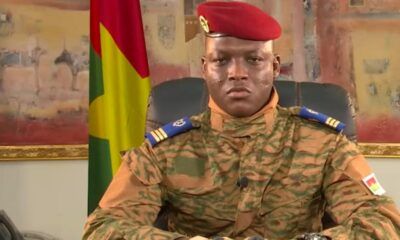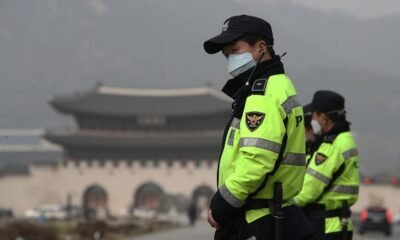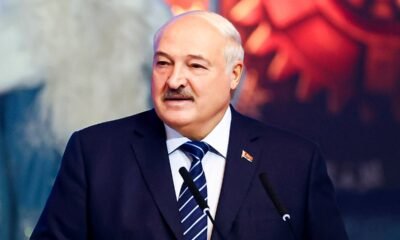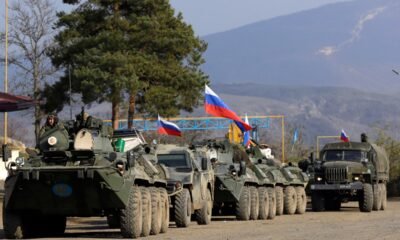INTERNACIONAL
Burkina Faso’s security forces are killing more civilians. Survivors detailed 1 village’s massacre

DAKAR, Senegal (AP) — Women slain with babies wrapped against their bodies, lifeless children intertwined together, a 2-month-old face-up on the ground with puppies crawling on his tiny frame. The scenes were horrifying, but the 32-year-old farmer felt he had to document them, as proof of the carnage in his central Burkina Faso village.
More than a dozen relatives were killed Nov. 5 when security forces attacked with mounted pickup trucks, guns and drones, he told The Associated Press on condition of anonymity, for fear of retaliation. He said he hid for hours in a neighbor’s compound and took a series of photos before fleeing the next morning.
PRIVATE PLANE CRASH KILLS 5, INJURES 2 IN BURKINA FASO
Dozens more were killed that day in Zaongo village, according to his account and that of two other survivors, as well as a U.N. report citing government figures. The images the man sent AP and the interviews with the three survivors are rare firsthand accounts amid a stark increase in civilian killings by Burkina Faso’s security forces as the junta struggles to beat back a growing jihadi insurgency and attacks citizens under the guise of counterterrorism.
Most attacks — including the slaying of children by soldiers at a military base last year, uncovered in an AP investigation — go unpunished and unreported in a nation run by a repressive leadership that silences perceived dissidents.
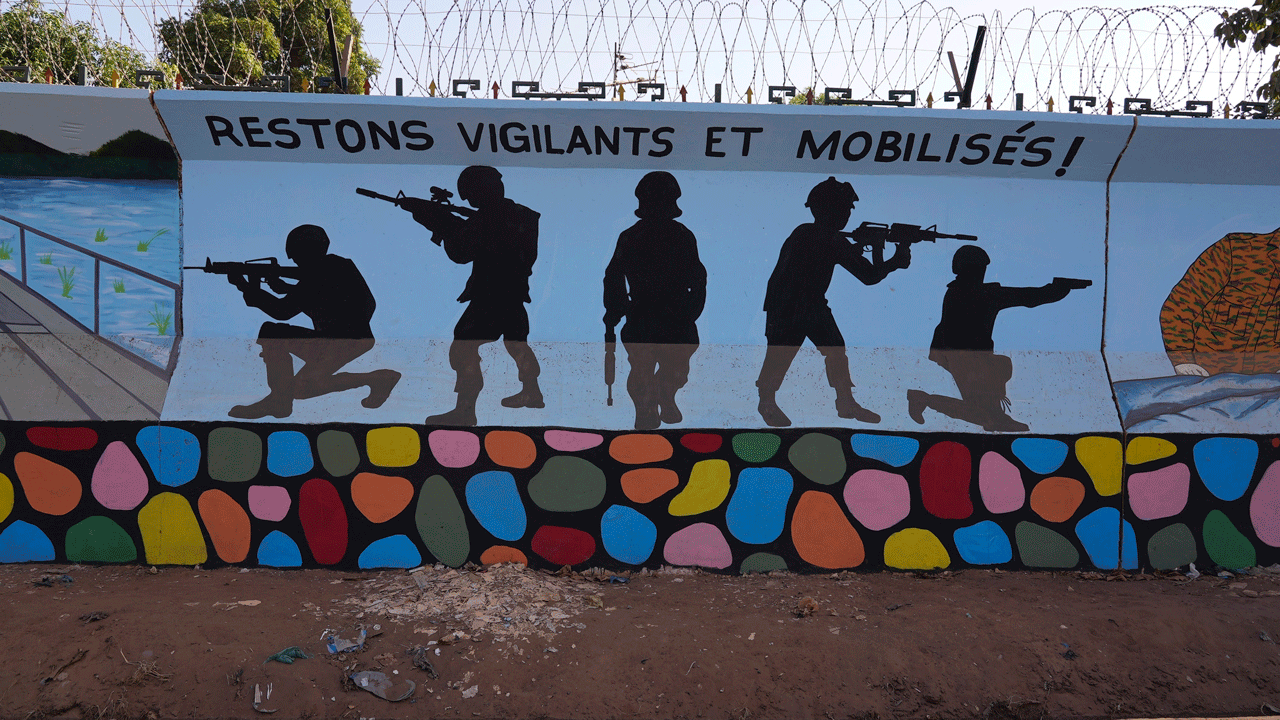
A mural is seen in Ouagadougou, Burkina Faso, Wednesday March 1, 2023. Three survivors of an attack in Zaongo, central Burkina Faso, told AP that dozens of people were killed in their village on Nov. 5 when security forces attacked. One of the survivors, a 32-year-old farmer, said he photographed the horrific scenes of bodies as proof of the carnage before fleeing. (AP Photo)
More than 20,000 people have been killed since jihadi violence linked to al-Qaida and the Islamic State group first hit the West African nation nine years ago, according to the Armed Conflict Location and Event Data Project, a U.S.-based nonprofit. The fighting has divided a once peaceful population, blockaded dozens of cities and led to two military coups.
Civilian deaths at the hands of security forces increased by 70% from 2022 to 2023 — to 735 people killed from 430, ACLED figures show.
Burkina Faso’s government spokesman didn’t respond to requests for comment about the Nov. 5 attack. Previously, officials have denied killing civilians and said jihadis often disguise themselves as soldiers.
The three survivors told AP they’re certain the men were security forces, not jihadis. They describe them wearing military uniforms, one with a Burkina Faso flag fastened to him as he tried to warn a group of civilians that anyone found alive would be killed. The farmer saw a helicopter flying toward the village in the attack’s aftermath — those are used solely by the military, not insurgents.
The United Nations urged the government to conduct an independent and transparent investigation into the attack, hold those responsible accountable, and compensate victims and families, said Seif Magango, spokesperson for the U.N. Human Rights Office.
Burkina Faso’s prosecutor’s office said it opened an investigation, but four months later, survivors said they’ve had no news.
«THEY MASSACRED THEM»
It was early morning when the farmer heard gunshots in the distance. He was cultivating land a few miles from home with his father, he said, and they returned to the village to wait it out.
Violence in Namentenga province is frequent, locals said — it’s common to hear shootings and see soldiers on patrol.
But this Sunday was different.
About 3 p.m., the farmer said, hundreds of men — most in military fatigues — stormed through on motorbikes and trucks and started indiscriminately killing people.
He hid at the neighbor’s home, he said, and after hours of gunshots, the man with the Burkina Faso flag entered, warning people to stay out of sight.
«The soldier told us that his colleagues were in the other compound,» the farmer said. «He said he didn’t want to hurt us, but if the others realized we were still alive, they’d kill us.»
When the guns stopped that evening, he said, he left the compound and saw Zaongo littered with dead and injured men, women and children. Among them were his father, two brothers, a sister and her four children.
His uncle’s body lay under a pile of several children. His 63-year-old father was by the door of their house.
«These people sought shelter in their huts, but they massacred them,» the farmer said.
THE JUNTA TODAY
It’s unclear what prompted the attack, but locals said most times, security forces think villagers are working with the extremists.
Since seizing power in the second coup in September 2022, the junta led by Capt. Ibrahim Traoré has threatened rights groups and journalists and carried out attacks against civilians — potential war crimes under international law.
Military drone strikes late last year claiming to target Islamic fighters killed at least 60 people at two markets and a funeral in Burkina Faso and neighboring Mali, according to Human Rights Watch.
The junta is on a war footing as it tries to beat back the jihadis, who’ve overtaken more than half the country, according to conflict analysts and Sahel region experts. It’s using a new general mobilization law to expand its crackdown and force people into combat.
The junta is distancing itself from regional and Western nations that don’t agree with its approach. This year, it left the West African regional economic bloc known as ECOWAS and created an alliance with Mali and Niger, also run by military juntas battling jihadi insurgencies.
The junta severed military ties with former colonial ruler France. Officials have welcomed several dozen Russians tasked in part with keeping the junta in power, according to several conflict experts and a diplomat who spoke on condition of anonymity because he wasn’t authorized to discuss the matter.
In November, days after the Zaongo massacre, 50 Russians arrived in Burkina Faso to protect the junta, influence public opinion and provide security services, said Lou Osborn with All Eyes on Wagner, a project focusing on the Russian mercenary group, which operates in a handful of African countries.
While the Wagner Group’s future has been uncertain since leader Yevgeny Prigozhin died in a suspicious plane crash last year, its presence in Burkina Faso is part of the group’s new and more visible phase of influence, Osborn said. A pro-Russian association called the Africa Initiative has been established and is staffed with former Prigozhin employees, she said.
Its goal, initiative president Soumaila Azenwo Ayo told AP, is promoting Russian and Burkina Faso culture and language, in part through its new radio program, «Russian Hour.»
Africa is key to Russia politically and economically as it seeks allies amid its war in Ukraine. But Wagner mercenaries have been accused by rights groups and civilians of committing human rights atrocities in the countries where it operates, including the killing of 300 people at a Mali village in 2022. An increased Burkina Faso presence would bring fear of even more civilian deaths.
The United States said it has cut and suspended assistance to Burkina Faso’s military but still supplies nonlethal equipment to civilian security forces such as the national police. In January, it delivered nearly 100 bikes and pickups.
In a statement, the State Department said it has provided $16 million in «counterterrorism capacity building assistance» to Burkina Faso since 2022.
«We are not aware of any diversion of misuse of recent equipment,» it said. «We take allegations seriously and will continue to monitor and evaluate use of our security assistance.»
Some analysts said continued U.S. aid sends the wrong message.
«Other countries around the world are seeing and watching and saying to themselves, ‘I can also jail all of my opponents, kill civilians under the guise of counterterrorism efforts and also play friendship with Russia, China — and the US will still give me all the toys I’ve asked for,’» said Aneliese Bernard, a former State Department official specializing in African affairs who runs a risk advisory group.
CIVILIANS IN THE MIDDLE
During the Nov. 5 attack, men in military uniforms speaking French and local language Moore called for all men to leave their houses, a 45-year-old mother told AP.
Peering through the window of the home where she hid, she said, she saw relatives being killed — more than 15 in all.
She said she was spotted by a soldier, who motioned for her to lie down and stay silent. The men dressed, looked and sounded like the soldiers who regularly pass through the village inspecting people’s documents, she said.
The third survivor who spoke to AP, a 55-year-old man from Zaongo, said villagers had been accused of working with the jihadis because they refused to join tens of thousands of volunteer fighters serving alongside Burkina Faso’s military.
Recruiting is part of the junta’s strategy, but residents said this has only contributed to civilian killings as volunteers round up anyone they suspect of ties to the extremists. It also provokes jihadis to attack communities with volunteers, they said.
Civilians are increasingly caught in the middle as violence intensifies. More than 2 million have been displaced and tens of thousands face severe hunger, according to the U.N. The insecurity makes it hard for aid groups to get assistance to those who need it.
At least 74 civilians were killed in connection with a weekslong convoy carrying food and aid in December, according to ACLED. They were killed by both the military and jihadis, two aid workers told AP on condition of anonymity because they weren’t authorized to speak about the matter. One worker said the jihadis accused the civilians of providing information to the convoy’s armed escort.
An internal report for aid workers seen by AP said soldiers escorting the food supplies «fired on suspected accomplices» of jihadi-affiliated fighters.
«WE’RE FRIGHTENED»
Four months after the attack, survivors fear that bodies still lie on the ground rotting in Zaongo, now occupied by jihadis. Some relatives were able to return about a week after the deaths, but there were too many bodies and not enough time to bury them all, they said. They’ve been unable to get back since.
CLICK HERE TO GET THE FOX NEWS APP
It’s still unclear how many people were killed – reports from survivors, the U.N. and aid groups vary, from 70 to more than 200.
Survivors are displaced in different parts of the country. They’re calling on the government to hold the killers accountable while living in fear that it could happen again.
«We never thought that so many people could be killed at once,» said the surviving woman who spoke to AP.
«When a door slams or a child shouts, we’re frightened. If we go back there, we’ll just die.»
INTERNACIONAL
Philippine fighter jet carrying 2 pilots goes missing during mission against insurgents in southern province

A Philippine air force fighter jet carrying two pilots went missing during a night combat assault in support of ground forces who were battling insurgents in a southern province, officials said Tuesday.
The FA-50 jet lost communication during the tactical mission around midnight on Monday before reaching a target area. A search for the jet is underway.
«We are hopeful of locating them and the aircraft soon and ask you to join us in prayer during this critical time,» Philippine air force spokesperson Col. Ma. Consuelo Castillo said.
CHINESE NAVY HELICOPTER FLIES WITHIN 10 FEET OF PHILIPPINE PATROL PLANE OVER DISPUTED SHOAL
Two Philippine Air Force FA-50 fighter jets fly during a joint patrol and training session with the U.S. over the South China Sea, Tuesday, Feb. 4, 2025. (Philippine Air Force via AP)
The other aircraft involved in the mission returned safely to an air base in central Cebu province, the air force said, without offering further details due to security reasons.
The incident happened in a southern Philippine province during an anti-insurgency mission against communist guerrillas, a Philippine military official told The Associated Press.
US FLIES JOINT PATROL WITH THE PHILIPPINES NEAR SHOAL REGION GUARDED BY CHINA

Two Philippine Air Force FA-50 fighter jets fly with two U.S. Air Force B-1 bomber aircraft during a joint patrol and training session over the South China Sea on Tuesday, Feb.4, 2025. (Philippine Air Force via AP)
It was not immediately clear if the other FA-50s would be grounded after the incident.
The Philippines acquired 12 FA-50s multi-purpose fighter jets from South Korea’s Korea Aerospace Industries Ltd. for 18.9 billion pesos, or $331 million, beginning in 2015. The acquisition was viewed at the time as the biggest deal under a military modernization program that had been repeatedly stalled by a lack of funds.
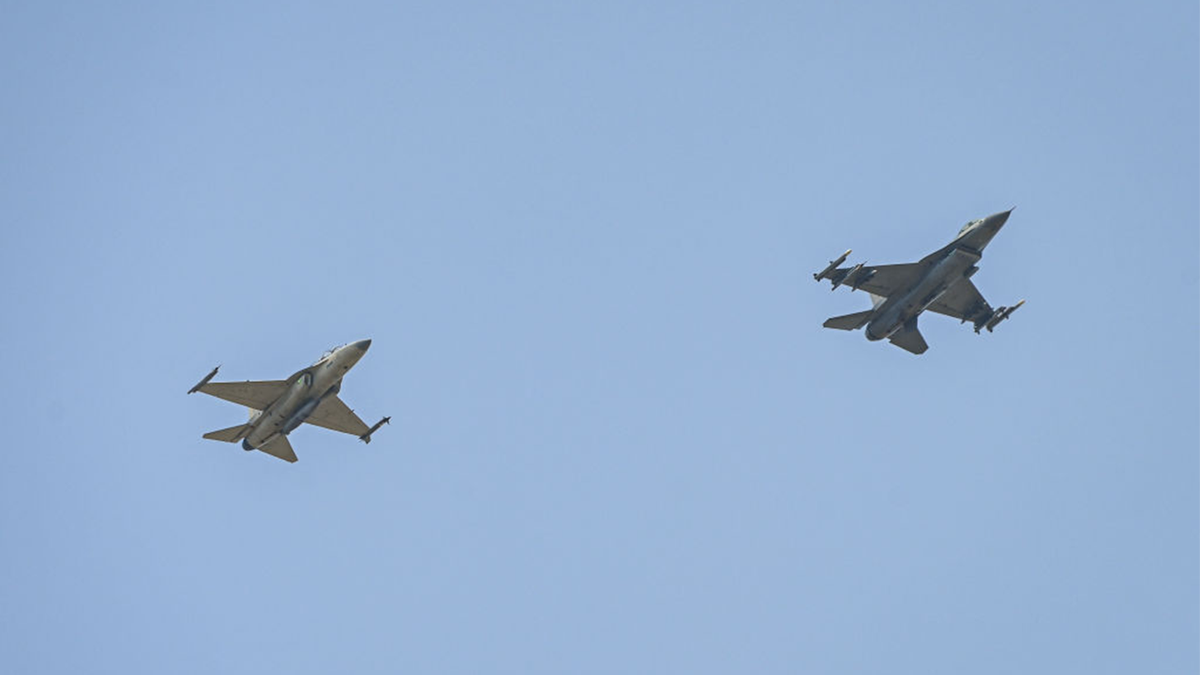
A Philippine Air Force FA-50, left, and U.S. Air Force F-16 fighter jet, right, fly in formation during the US-Philippines joint air force military exercise dubbed ‘Cope Thunder’ at Basa Air Base in Pampanga on April 11, 2024. (Getty Images)
CLICK HERE TO GET THE FOX NEWS APP
In addition to anti-insurgency missions, the jets have been used for various other activities, including major national ceremonies and patrolling the disputed South China Sea.
The Associated Press contributed to this report.
INTERNACIONAL
Trump’s threats against Canada boost Trudeau’s Liberal Party in the polls as new tariffs set to begin

OTTAWA, Canada — As new tariffs came into effect on Tuesday, analysts say that if Canada’s Liberal Party holds onto power, the party can thank President Donald Trump in part for such a reversal of political fortune.
Since Trump’s inauguration, Canada’s official opposition Conservative Party – once leading the governing Liberals by a wide margin – has seen their popularity in public-opinion polls gradually decline.
An Ipsos poll released last week found that, for the first time since the Liberals won the last federal election in 2021, they’re ahead of the Conservatives by two points, with 38% popularity compared to the Conservatives at 36%. Six weeks earlier, the Conservatives were leading the Liberals by 26 points. A general election is expected to be called as early as this spring by Trudeau’s successor, who will be announced on Sunday.
Darrell Bricker, CEO of Ipsos Global Public Affairs, told Fox News Digital that he has never seen a party experience such a rapid and dramatic drop during his four-decade career in polling.
WHO IS PIERRE POILIEVRE? CANADA’S CONSERVATIVE LEADER SEEKING TO BECOME NEXT PRIME MINISTER AFTER TRUDEAU EXIT
Canada Conservative Leader Pierre Poilievre holds a news conference in a hotel ballroom in Ottawa on Dec. 1, 2024. (Justin Tang/The Canadian Press via AP)
He believes the Conservatives’ decline is attributable to two factors.
Justin Trudeau, whose personal popularity has plummeted since he became Canada’s 23rd prime minister in 2015, will step down as head of the Canadian government and Liberal Party on March 9; «And the threat from Trump to use economic force on Canada to bend us to his knee and possibly absorb us as a 51st state,» explained Bricker, about the president’s planned tariffs against Canada and his repeated references regarding annexation.
Throughout February, Nanos Research found the gap narrowing between the Liberals and Conservatives, who the month before were poised to form a «super-majority» government with as many as 240 members of Parliament (MPs) in an expanded 343-seat House of Commons that takes effect after the next general election.
«That’s completely out the window now,» said Nik Nanos, founder and chief data scientist of the Canadian polling firm, who also believes Trudeau’s imminent departure and Trump’s rhetoric against Canada have contributed to the Liberals’ bump in the polls.
The president «has effectively changed the ballot question from: Is it time for a change? – which was bad news for the Liberals – to who can best deal with Donald Trump, the new existential threat to the Canadian economy?» offered Nanos.

Mark Carney, the former governor of the Bank of Canada, officially announced his bid for the federal Liberal Party leadership in Edmonton, Canada, on Jan. 16, 2025. (Artur Widak/NurPhoto via Getty Images)
He explained that Canadian Conservative Official Opposition Leader Pierre Poilievre and his party played a part in the Liberals’ boost by «showing they were a little out of touch» in focusing on the Liberal government’s tax on carbon emissions and vowing to remove it while Canadians became increasingly concerned about Trump’s threats.
«In hindsight, when the Conservatives had a 27-point advantage in our polling, it didn’t have anything to do with Pierre Poilievre being strong or liked, or the Conservatives being brilliant strategists,» said Nanos. «It all had to do with dislike of Justin Trudeau and people wanting change and the Conservatives being the agent of change.»
According to the Ipsos poll, 86% percent of 1,000 respondents said that they want a general election «immediately» to have a federal government «with a strong mandate» to deal with Trump’s tariff threat.
Bricker said the Liberals’ lead in the polls, particularly in Canada’s most populous provinces of Ontario and Quebec, over the Conservatives could even widen should Mark Carney, the former governor of the central banks of England and Canada and the frontrunner in the Liberal leadership race, succeed Trudeau as prime minister.
INFLUENTIAL LEADER OF CANADA’S ONTARIO PROVINCE SEEKS TRUMP, MUSK MEETING: US ‘NEEDS US LIKE WE NEED THEM’

President Donald Trump signs an executive order in the Oval Office on Feb. 25, 2025. (Pool)
Veteran Canadian pollster Angus Reid said the latest polling by his company found that 51% said Carney and the Liberals were best suited to improve relations with the U.S., including on tariffs, compared to 35% who chose the Conservatives under Poilievre, who is seen by many Canadians as holding a «Trump-light agenda.»
From south of the border, the president has «eroded Conservative support because it completely changed the political dynamic in Canada, completely changed what could be considered the most important ballot question that was all about getting rid of some of the baggage from the Trudeau era,» explained Reid, founder and chair of the Angus Reid Institute.
«Now it’s one of defending the sovereignty and economy of the country.»
Another Angus Reid poll found that with Carney as Liberal leader, his party is virtually tied at 44% with the Conservatives, at 45% on voting intention. In Quebec, a Carney-led Liberal Party enjoys 31% support compared to the Conservatives at 22%.

Guests display a giant Canadian flag before a flag-raising ceremony on Feb. 15, 2025, in Toronto. (Yu Ruidong/China News Service/VCG via AP)
Reid said the annexation and tariffs issue especially resonates with Quebecers more than any other region in Canada.
Carney’s further challenge for Poilievre is that the former «on paper, looks like a Conservative,» said Nanos.
«The guy worked in the banking sector and the private sector, like Goldman Sachs, and chaired, until recently, large enterprises like Bloomberg and Brookfield [Asset Management]. He walks and talks like a Conservative.»
Carney, an Oxford-educated economist who has never held elected office, is expected to call a snap election should he be chosen as Trudeau’s successor.
CLICK HERE TO GET THE FOX NEWS APP
If the polling numbers continue to rise in favor of the Liberals, they could not only win the national vote in such a contest but form a majority government, added Reid.
Currently, the Liberals have 153 MPs in the 338-seat House of Commons, which constitutes a minority government.
INTERNACIONAL
«Estamos abandonados por todo el mundo»: entrevista al pediatra palestino que operó, salvo vidas y lo perdió todo

¿Gaza convertida en la Costa Azul?
-
POLITICA2 días ago
Nueva encuesta y sorpresa en la Ciudad: lidera un radical K y está tercero un abogado de famosos
-
POLITICA3 días ago
Javier Milei y sus medidas, EN VIVO: en un Congreso repleto de faltazos, el Presidente habla en cadena nacional para abrir la sesiones ordinarias
-
POLITICA10 horas ago
Javier Milei advirtió a Grupo Clarín que no autorizará la compra de Telefónica

